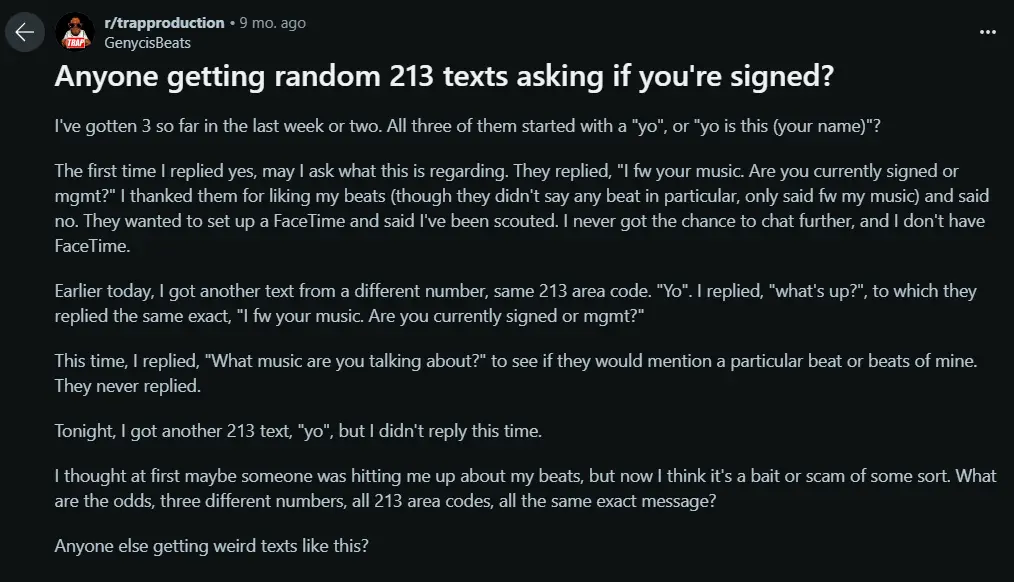Digital technology helps in communicating with others and makes it quicker and easier. However, this convenience has also increased in online crimes. A common example of these crimes is the 213 Area Code Text Scam.
In this scam, scammers use tricky messages to fool people into sharing personal or financial details. What makes this scam dangerous is that it begins with a harmless-looking text, which draws people into a trap.
In this post, we will explain how this scam works, explore its different forms, and summarize ways to protect yourself from becoming a victim.
213 Area Code Text Scam Overview
The scam usually starts with a casual text message from a random 213 area code number. These messages often begin with a simple greeting like “yo” or “yo, is this [your name]?” This friendly tone is meant to make the message seem genuine.
The scammer follows up with a positive comment, Are you signed or have management?” Using casual slang like “fw” makes it seem like the sender is a industry insider.

For many aspiring artists and producers, a message like this can be exciting. Breaking into the music industry is tough, so any sign of interest from someone who seems to be a professional can feel like a big opportunity.
However, the FaceTime call is just a trick. It either never happens or is used to collect more personal information. The scammer asks for personal details or even requests money for “future placements” or other fake promises.
How Does 213 Area Code Text Scam Work?
The 213 area code scam starts with an unexpected text from an unknown number, saying something as simple as “Yo” or asking a casual question. The scammers want to get the recipient to respond catching them off guard and pulling them into a conversation.
Once the recipient replies the scammer begins to build trust. They claim they contacted the wrong number or say they found the recipient’s number on an old phone. The scammer invents a story about being new in town or looking for friendship.
To make the interaction seem more genuine, they share personal stories or send photos, which are stolen from the internet.
As the conversation continues, the scammer weaves a more complex web of lies. They express romantic interest and offer a fake business opportunity or suggest they have valuable information to share.
They want to make the victim feel trust or even a sense of obligation. At this stage, the scammer starts asking for personal information like the victim’s full name, address, or financial details.
They could also request money and claim it’s for a job processing fee, an emergency loan, or another reason.
Ultimately, the scammer wants to steal something valuable from the victim, whether it’s personal information for identity theft or direct financial gain through wire transfers, gift cards, or online payments.
When victim realizes what’s happening they have already lost money or exposed sensitive information.
Variations of the 213 Area Code Text Scam
The 213 Area Code Text Scam doesn’t follow one pattern. Scammers are skilled at adjusting their methods to fit various situations. Some of the most common tactics include.
1. Romance Scams
In these scams, the scammer acts to be interested in the victim. They spend weeks or even months building a relationship only to eventually ask for money. They provide convincing reasons, such as medical emergencies, travel costs, or financial troubles.
2. Job Scams
In this approach, the scammer offers a remote job that promises high pay and seems almost too good to pass up. However, to get the job, the victim is required to pay for things like training materials, equipment, or background checks.
3. Investment Scams
In this tactic, the scammer claims to have exclusive knowledge of a profitable investment, involving cryptocurrency. They convince the victim to invest money with the promise of high returns. However, once the victim transfers the funds they disappear.
How To Protect Yourself From These Scams?
To protect yourself from the 213 Area Code Text Scam, stay alert and take action with these steps.
Ignore Suspicious Texts: If you get a text that seems suspicious, don’t reply. Responding allows the scammer to know your number is active, which could direct you to more scams.
Block the Number: Use your phone’s settings to block the number that sent the suspicious message. Most smartphones allow you to block specific numbers and mark them as spam.
Delete the Message: Delete the message to remove any temptation to click on links or respond, which helps prevent accidental engagement with the scam.
Report the Scam: Reporting the scam helps authorities track and shut down these schemes. You can report it to the Federal Trade Commission (FTC) at ReportFraud.ftc.gov. This helps protect both you and others from similar scams.







